
It is rare in this day and age to have the opportunity to experience traditional rituals and practices and listen to Quan Ho singing (Ca su at the Communal House).
In particular, the successful restoration of the solemn worship ceremony at the village communal house has affirmed the efforts of generations of artisans in Hoai Trung in fully preserving this intangible cultural heritage.
Quan Ho is not only a series of smooth antiphonal songs, but also an art of communication and behavior, a complex cultural system.
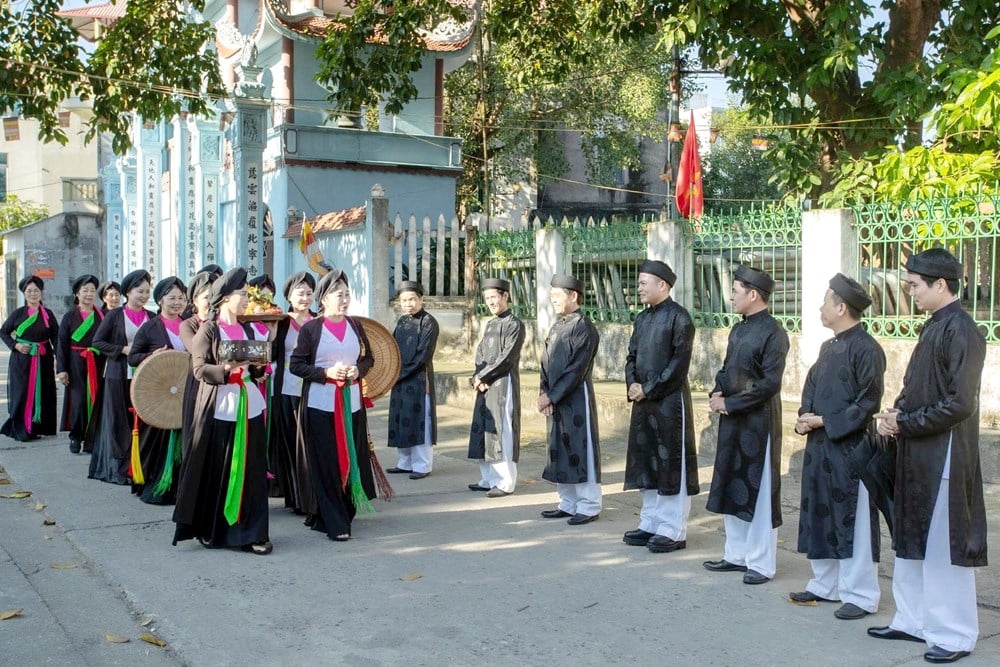
From the village gate, the Lien Anh (literally "lien anh") stand to welcome Quan Ho friends. In ancient Quan Ho villages, if a person wants to become a true Lien Anh or Lien Chi (literally "lien anh"), he or she must first learn the etiquette to become a Quan Ho person.
In Quan Ho Hoai Trung village, a place with a rich history and old stories of profound humanistic values, Quan Ho people are more refined, elegant, gentle, and value meaning and affection more than anything else.
Mr. Duong Duc Thang, Vice President of Hoai Trung Quan Ho Club, said that Hoai Trung is a rare Quan Ho village that still preserves the traditional customs of Quan Ho artists from ancient times, from all rituals and manners to values of behavior and communication style.

Hoai Trung people still preserve the traditional customs of Quan Ho artists from ancient times, from all rituals and manners to values of behavior and communication style.
According to Mr. Thang, in ancient Quan Ho villages, a person who wants to become a true Lien Anh or Lien Chi must first learn the etiquette to become a Quan Ho person.
Quan Ho singers must be humble and disciplined. They must communicate skillfully, and each conversation must be conducted with carefulness and respect.
Welcoming Quan Ho friends is a solemn ritual, following strict rules, from clothing to speech.
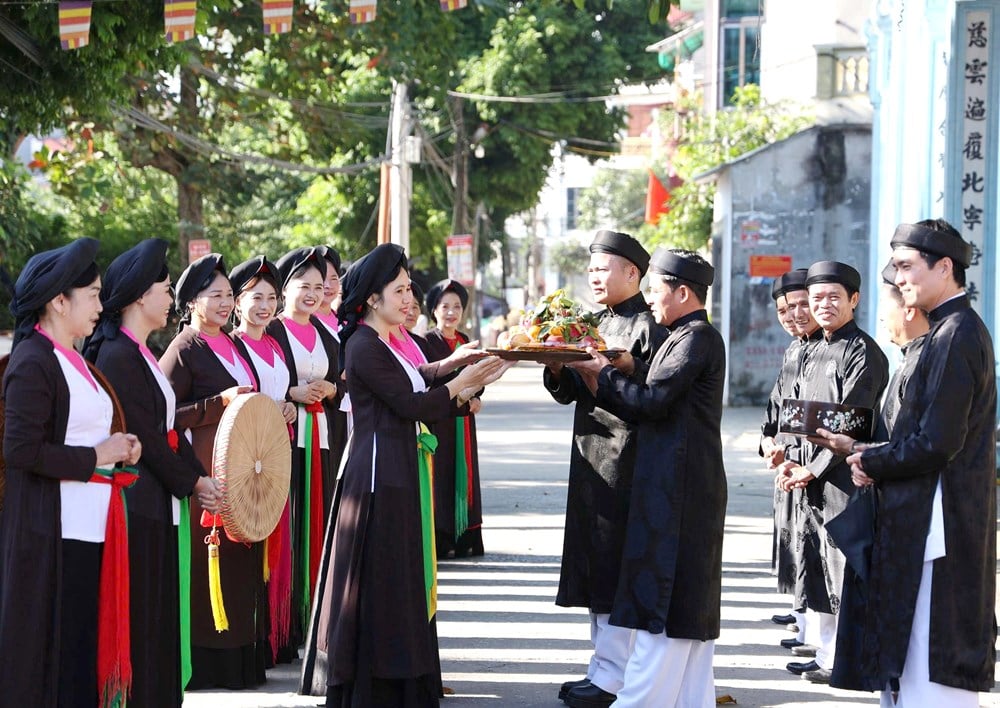
Quan Ho "guests" give offerings to the Saints
Mr. Duong Duc Thang said that the culture of behavior, communication, and treating each other with respect and affection is the root of Quan Ho.
When donning the costume and singing Quan họ, there is an unchangeable rule of address, showing absolute humility: the Lien anh and Lien chi singers are never allowed to call themselves “anh hai, anh ba, chi hai, chi ba”. They only call themselves “chung em”; the titles “anh hai, chi hai” are only used for their Quan họ friends to call, as a way to honor friends.
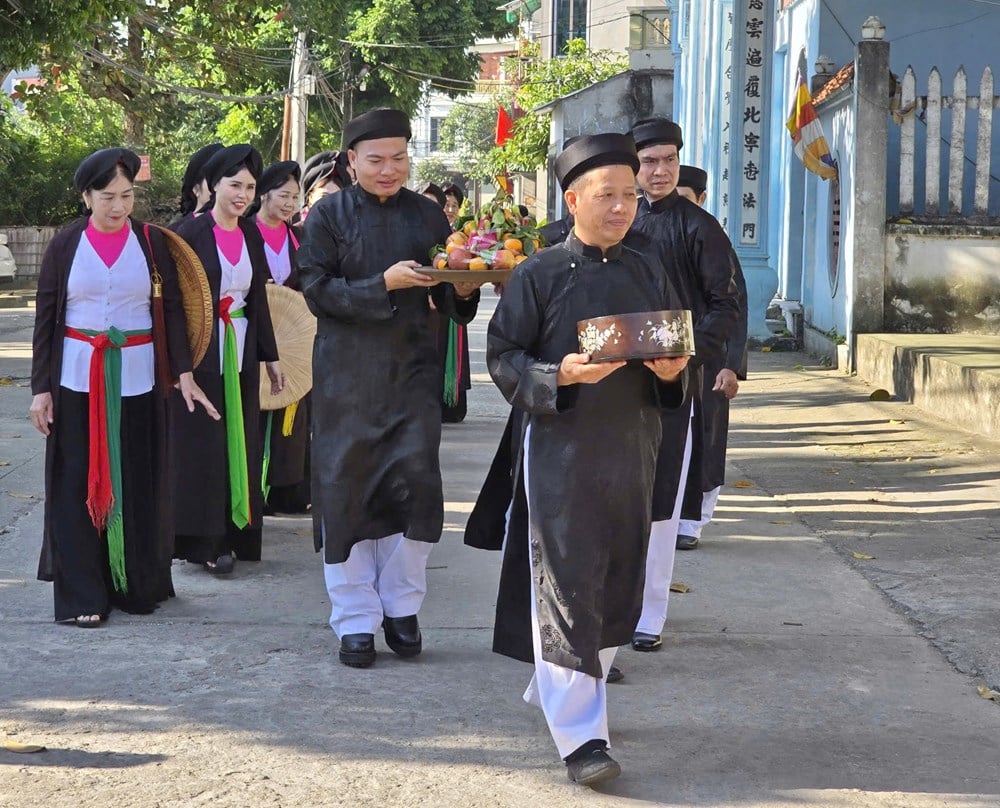
The Quan Ho "owners" receive and bring offerings to the village communal house.
To welcome guests, the Hoai Trung Quan Ho singers appeared in five-paneled costumes and turbans; the "three-piece seven-piece" costumes, crow-beak scarves, and conical hats of the female singers.
This neatness not only highlights the gentle beauty of Kinh Bac people but also shows respect for Quan Ho singers and the upcoming ceremony.
From the village gate, the welcoming ceremony takes place through a series of exemplary greetings, showing the highest respect. The “host” Lien Anh (male) players line up neatly to welcome the Lien Chi (female) guests.

When meeting each other, the brothers and sisters immediately said their first greetings. The "host" immediately said: "Yes, we brothers and sisters greet the second, third, fourth and fifth sisters in Quan Ho singing!"
The "guest" immediately replied: "Yes sir! We also send greetings to the second, third, fourth and fifth brothers who are performing Quan Ho!"
Then, the "owner" said: "Yes! Every year is a tradition, a new year is a new spring, today we villagers remember the old tradition, we have the Quan Ho Lien Chi leader to spare some of his precious time; first to visit the village, then to invite the Quan Ho Lien Chi leader to visit the communal house to perform the ceremony, then we will continue to talk!".
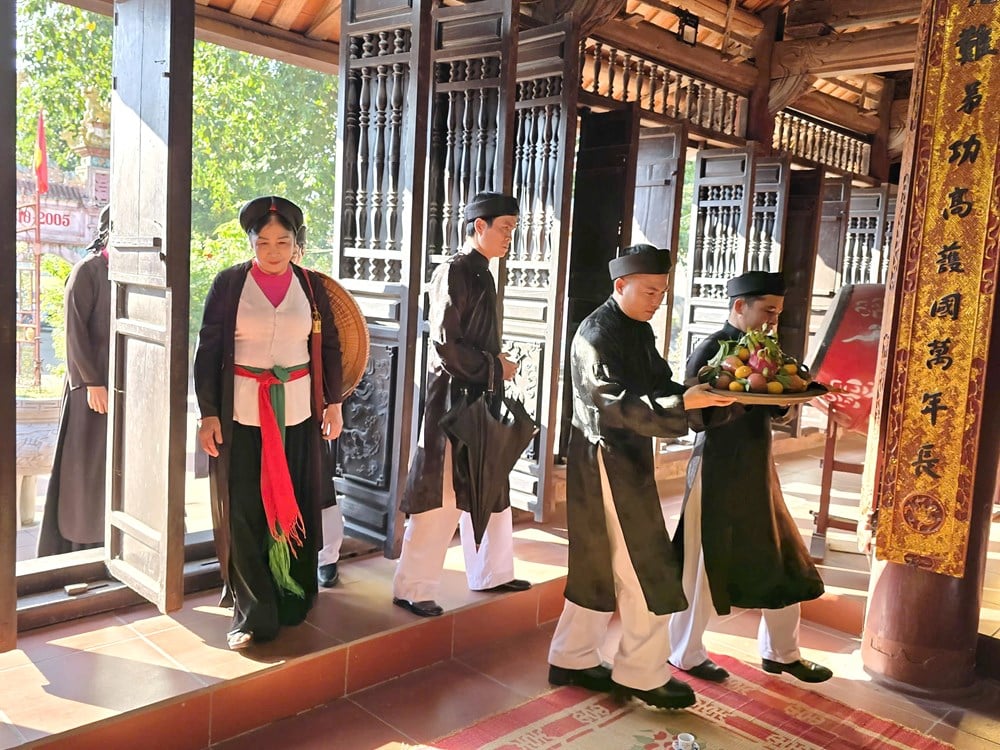
The "guest" sister immediately responded: "We received an invitation from the second, third, fourth, and fifth brothers who are performing Quan Ho on the occasion of the village's old tradition. We have a small gift.
First, we would like to attend the Mass, then we would also like to visit the homes of our second, third, fourth, and fifth brothers!".
This whole process of greeting and sending recreates ancient communication practices, showing the spirit that "Quan Ho is not just about singing. Before singing Quan Ho, one must learn to be a Quan Ho person."
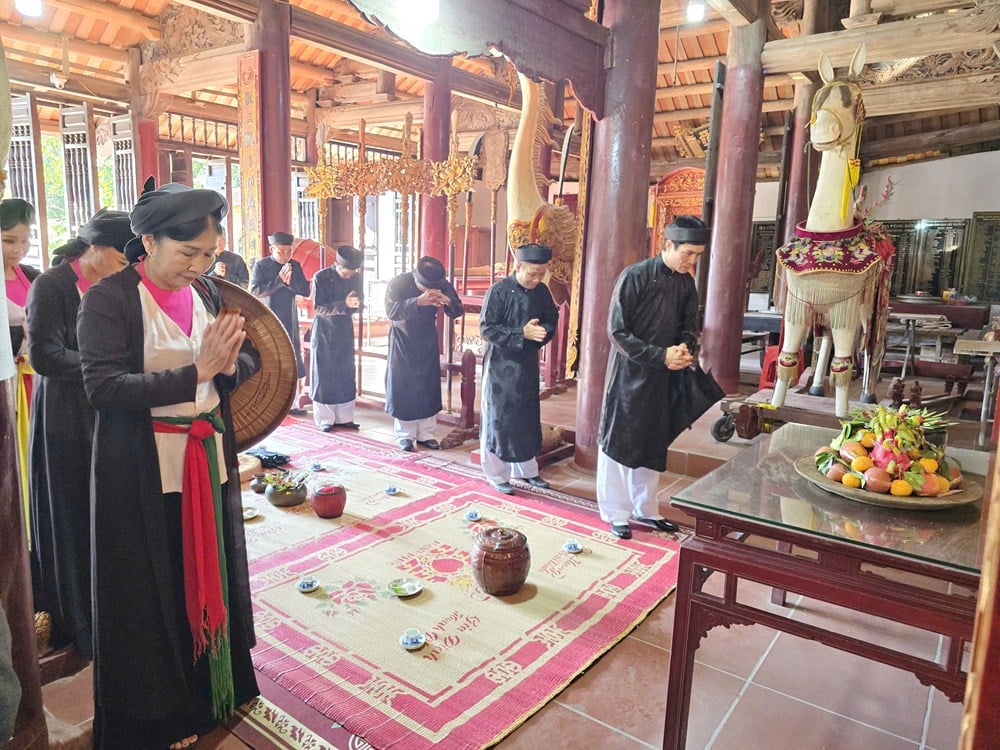
The brothers and sisters perform a ceremony before singing Quan Ho Ca Tho.
In the restoration activities of the Hoai Trung Quan Ho Club, worship singing (Ca su tai Dinh) is the most prominent ritual, demonstrating the beliefs and solemnity of ancient Quan Ho.
Hoai Trung people are proud to have the village communal house, which is a place to worship three tutelary gods: De Nhat, De Nhi, De Tam, according to legend, three generals who contributed to the national liberation during the Hai Ba Trung uprising against To Dinh.
Presently, in the relic site, there is still a copy of the sacred book carved on wood, copied from the original on a beautiful day in May, year Thanh Thai 12 (1900), compiled by the Imperial Academy of Rites, Grand Scholar Nguyen Binh Phung, year Hong Phuc 1 (1572).
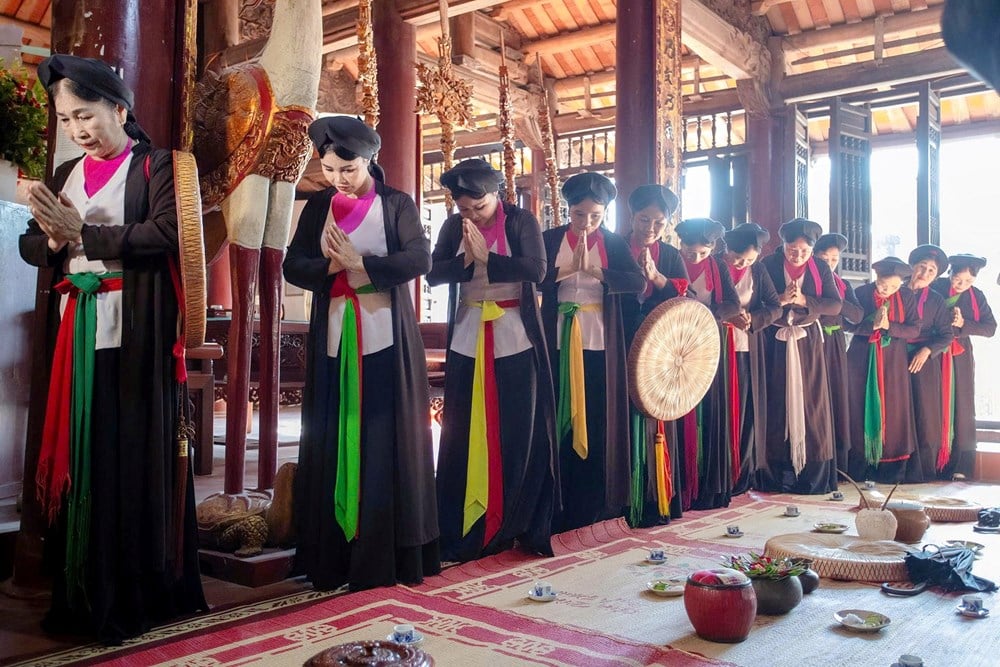
Hoai Trung Communal House was originally built during the Le Dynasty. During the Nguyen Dynasty, the Communal House was built on a large scale. In 1948, the structure was demolished, and the materials of the Communal House were used to help build the village to fight against the enemy and protect the people. It was not until 2000 that Hoai Trung Communal House was restored on the old foundation.
It is in this sacred space that the worship ritual is recreated closely according to old customs.
The entire worship ritual is a series of actions that are carefully arranged, neat and full of culture.
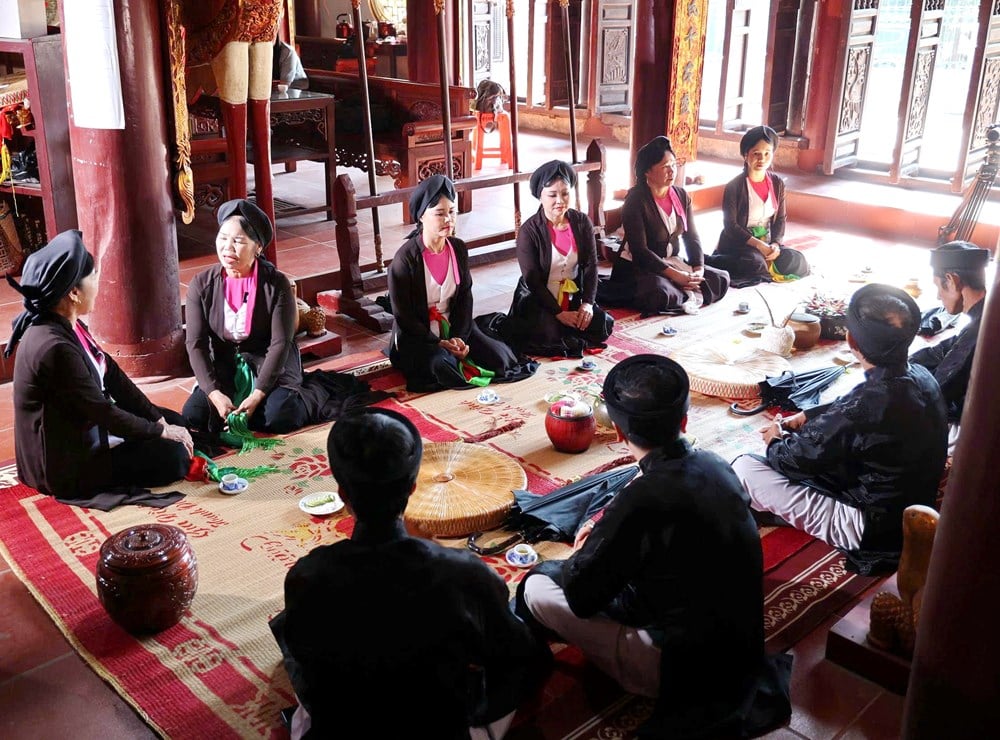
The two sides exchanged a few words before singing a song to the Saint.
The “host” Quan Ho performers must go to the village gate or the entrance of the communal house to welcome their guests. The “guest” Quan Ho performers must first ask permission from Mr. Dam to be welcomed into the communal house. After that, they offer gifts for Thanh Hoang to witness.
The two sides exchanged a few words before singing to the Saint: "Yes, it's been a long time since the Quan Ho sisters came to visit us. Today, Tet is here, Spring is here, our village is holding a festival to pray for joy, the Quan Ho sisters came to visit, first because Quan Ho values worship, and secondly, to let us brothers learn a few ways.
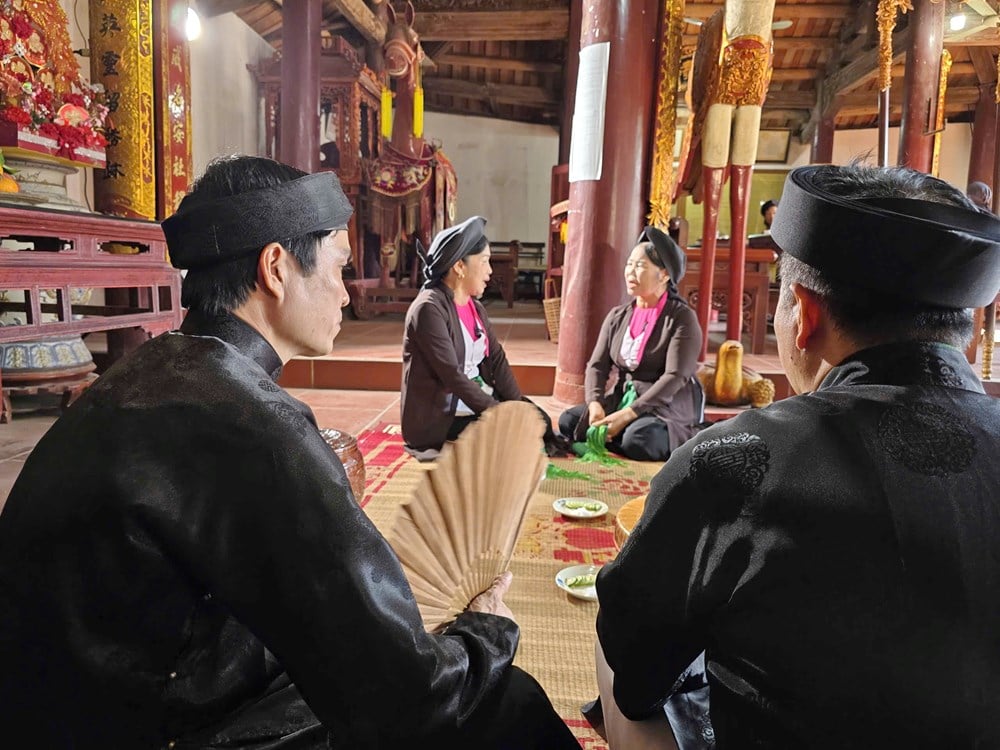
Singing is to serve the Saints, therefore, it must follow strict rules regarding voice and content.
We invited the Quan Ho singer to have a meal and a drink, then the Quan Ho singer sang the "ca su" first, so we sisters could follow.
Mr. Duong Duc Thang said that worshiping music is singing to serve the Saints, therefore, it must follow strict rules regarding voice and content.
In particular, only sing with the La Rang voice. This is a slow, solemn voice, suitable for a sacred atmosphere. Absolutely do not sing with the "odd" voice, the "small" voice, or the "goodbye" voice, because these voices are often used for outside play.

The main worship song is in La Rang's voice, praising the merits of the village's tutelary god, praying for national peace and prosperity, family happiness, good health for everyone and a bountiful harvest.
The content of the worship song only praises the merits and virtues of the village's tutelary god. The purpose is to pray for national peace, family happiness, good health and bountiful harvests.
Absolutely do not talk about love in the Ca su verses at the Dinh.
Affection and grace are the essence of Quan Ho, but in the sacred space, personal love must give way to love for the village and love for the country. The verses used in this ceremony are all famous, typical of folk songs: "The first time I stepped into the communal house", "Church for the most sacred", "Outside the house for today's funeral" and "Church for our village festival".

After the worshiping ceremony is over, the Quan Ho "host" must "say" thanking the Quan Ho "guest"
After the worshiping song is finished, the Quan Ho "host" must have a "word" to thank the Quan Ho "guest". At the end of the sacred ritual at the Communal House, the Quan Ho "host" invites the Quan Ho friends to the "Chau" (a place for receiving guests and singing love songs) to welcome them, eat rice and start other love songs (singing congratulatory songs, singing happy songs, singing festivals, or ancient songs such as "Hula", "Khoan khoan bo mu rowing do", "Ruong nam sao"...).
Restoring ancient rituals such as worship is not only a cultural activity but also a mission to preserve heritage.
Mr. Duong Duc Thang said that to fully restore, there needs to be exchange and combination between Quan Ho clubs to create richness, true to ancient customs.
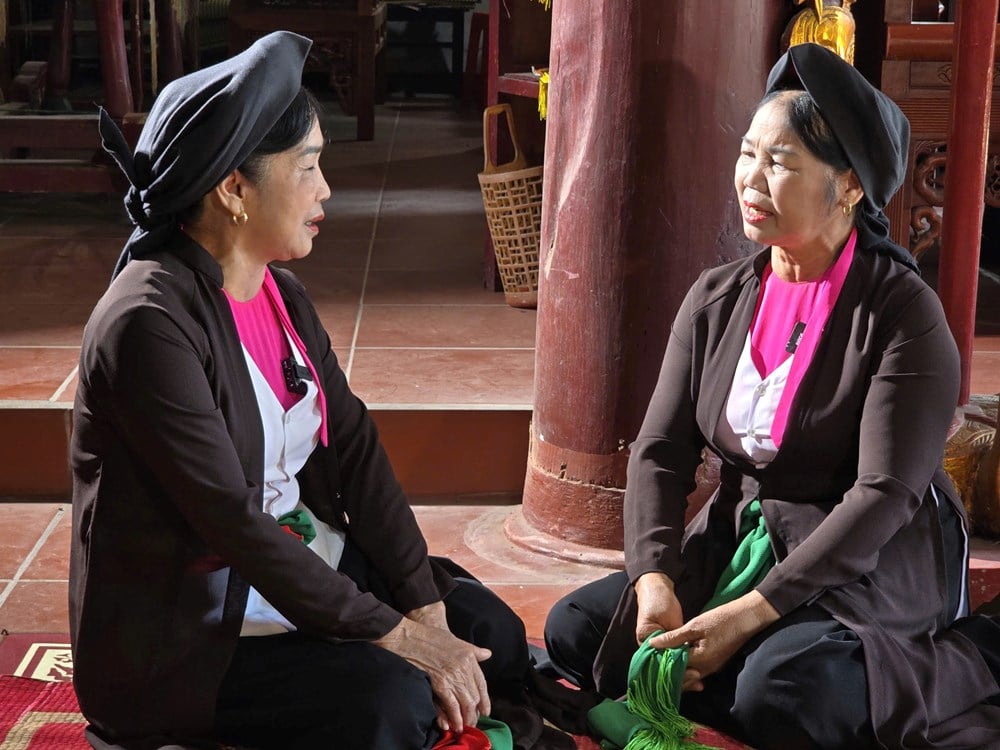
To sing the worship song, it is necessary to select outstanding artists who are knowledgeable and have good vocal qualities.
“We must select typical, knowledgeable and talented artists to serve as models and spread the traditional spirit.
We hope that this very refined lifestyle and cultural behavior will be passed on to the next generation of Quan Ho singers, preserving and promoting the heritage," said Mr. Duong Duc Thang.
Worshiping is one of the activities that Quan Ho Hoai Trung singers have restored on the traditional foundation left by generations of artisans in Hoai Trung and other Quan Ho regions.
It is rare in these days to have the opportunity to experience traditional rituals and practices and listen to singing at the communal house.
Hoai Trung is one of the few Quan Ho villages that still preserves those traditional rituals and customs thanks to the collection and restoration work of Mr. Duong Duc Thang and the Lien Anh and Lien Chi singers in Kinh Bac.
Source: https://baovanhoa.vn/van-hoa/le-nghi-nghiem-can-cua-quan-ho-ca-tho-182835.html



![[Photo] National Assembly Chairman Tran Thanh Man holds talks with South Korean National Assembly Chairman Woo Won Shik](/_next/image?url=https%3A%2F%2Fvphoto.vietnam.vn%2Fthumb%2F1200x675%2Fvietnam%2Fresource%2FIMAGE%2F2025%2F11%2F20%2F1763629724919_hq-5175-jpg.webp&w=3840&q=75)

![[Photo] Lam Dong: Panoramic view of Lien Khuong waterfall rolling like never before](/_next/image?url=https%3A%2F%2Fvphoto.vietnam.vn%2Fthumb%2F1200x675%2Fvietnam%2Fresource%2FIMAGE%2F2025%2F11%2F20%2F1763633331783_lk7-jpg.webp&w=3840&q=75)
![[Photo] President Luong Cuong receives President of the Senate of the Czech Republic Milos Vystrcil](/_next/image?url=https%3A%2F%2Fvphoto.vietnam.vn%2Fthumb%2F1200x675%2Fvietnam%2Fresource%2FIMAGE%2F2025%2F11%2F20%2F1763629737266_ndo_br_1-jpg.webp&w=3840&q=75)

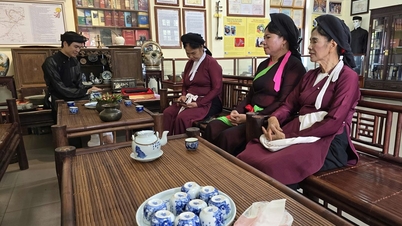
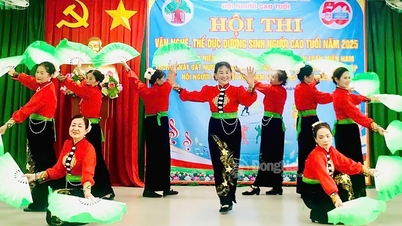

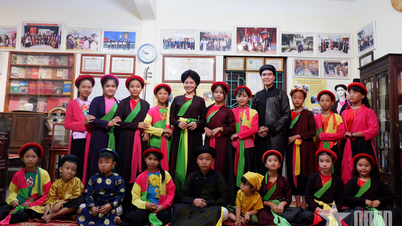







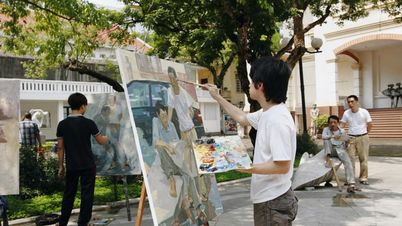


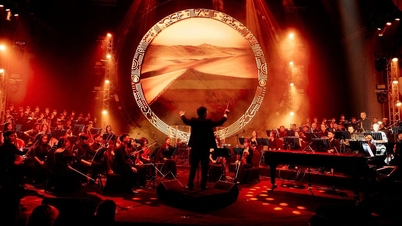



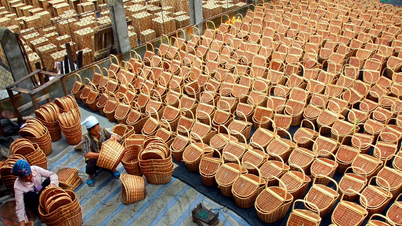




















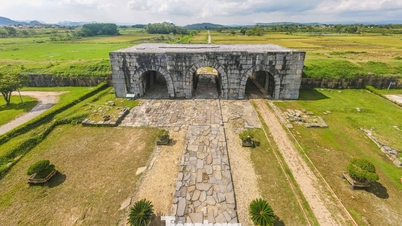

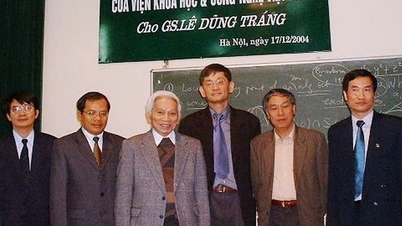


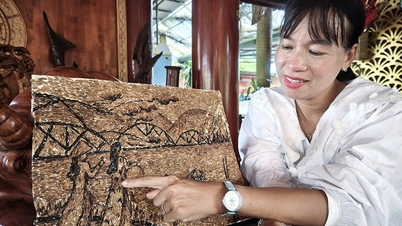



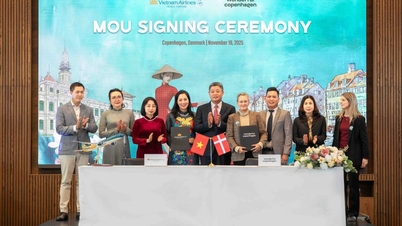














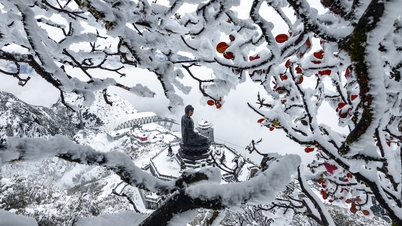














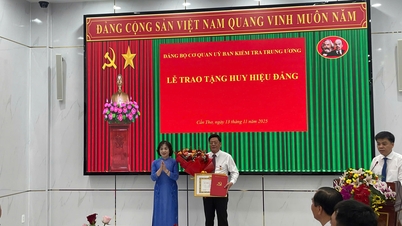


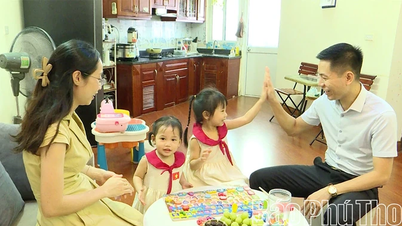

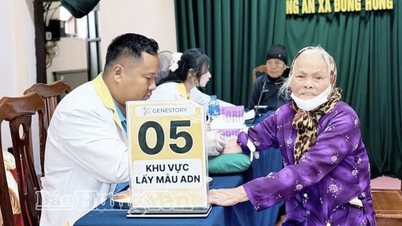






















Comment (0)